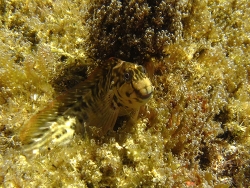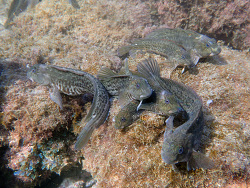Info
(Valenciennes, 1836)
Biology:
The rockpool blenny Parablennius parvicornis, is found in areas of volcanic rock in tidepools to a depth of 1m - 2m.
Distribution:
Atlantic Ocean: Mauritania to Congo, including the Canary Islands, Cape Verde and Madeira. Also reported from Morocco and the Azores.
Biology:
Inhabits the shallow littoral zone, in areas exposed to sunlight, between algae-covered pebbles.
Feeds almost exclusively on algae.
Oviparous. Eggs are demersal and adhesive.
Synonyms:
Blennius bouvieri Rochebrune, 1880
Blennius canariensis Jordan & Gunn, 1898
Blennius parvicornis Valenciennes, 1836
Pictiblennius parvicornis (Valenciennes, 1836)
Jumping guard
A jumping guard prevents (nocturnal) fish from jumping out.
Wrasses, blennies, hawkfishs and gobies jump out of an unprotected tank in fright if their night rest is disturbed, unfortunately these jumpers are found dried up in the morning on carpets, glass edges or later behind the tank.
https://www.korallenriff.de/en/article/1925_5_Jump_Protection_Solutions_for_Fish_in_the_Aquarium__5_Net_Covers.html
A small night light also helps, as it provides the fish with a means of orientation in the dark!
Biology:
The rockpool blenny Parablennius parvicornis, is found in areas of volcanic rock in tidepools to a depth of 1m - 2m.
Distribution:
Atlantic Ocean: Mauritania to Congo, including the Canary Islands, Cape Verde and Madeira. Also reported from Morocco and the Azores.
Biology:
Inhabits the shallow littoral zone, in areas exposed to sunlight, between algae-covered pebbles.
Feeds almost exclusively on algae.
Oviparous. Eggs are demersal and adhesive.
Synonyms:
Blennius bouvieri Rochebrune, 1880
Blennius canariensis Jordan & Gunn, 1898
Blennius parvicornis Valenciennes, 1836
Pictiblennius parvicornis (Valenciennes, 1836)
Jumping guard
A jumping guard prevents (nocturnal) fish from jumping out.
Wrasses, blennies, hawkfishs and gobies jump out of an unprotected tank in fright if their night rest is disturbed, unfortunately these jumpers are found dried up in the morning on carpets, glass edges or later behind the tank.
https://www.korallenriff.de/en/article/1925_5_Jump_Protection_Solutions_for_Fish_in_the_Aquarium__5_Net_Covers.html
A small night light also helps, as it provides the fish with a means of orientation in the dark!







 Prof. Dr. Peter Wirtz, Madeira
Prof. Dr. Peter Wirtz, Madeira

























